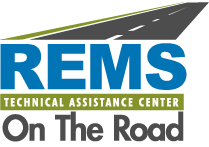|
Planning Professional Development Activities for Educators
This Summer? Add Emergency Preparedness
and Building Safety to the Agenda!
 The school year is ending for many, but we know that
the work of education agencies and their community
partners in safety doesn’t stop when students retreat
from the classroom during summer break! With the decrease
in traffic on campus, summer can serve as an ideal
time for some important activities in your planning process,
including reviewing emergency operations plans (EOPs)
and back-to-school safety procedures with staff and
other key stakeholders. The REMS TA Center offers the
following recommendations to consider as schools and
institutions of higher education welcome the summer
season and begin to prepare for the 2017-2018 academic year.
The school year is ending for many, but we know that
the work of education agencies and their community
partners in safety doesn’t stop when students retreat
from the classroom during summer break! With the decrease
in traffic on campus, summer can serve as an ideal
time for some important activities in your planning process,
including reviewing emergency operations plans (EOPs)
and back-to-school safety procedures with staff and
other key stakeholders. The REMS TA Center offers the
following recommendations to consider as schools and
institutions of higher education welcome the summer
season and begin to prepare for the 2017-2018 academic year.
-
Communicate staff roles and responsibilities in the event of a wide
variety of hazards and threats. EOPs are great resources, but
they have no value if the people who need to use them during
an emergency aren’t sure about what to do. Staff need to be trained
and retrained before an emergency occurs. Use professional development
sessions planned right before the start of the next school year as
opportunities to review courses of action the members of your
incident response team will take as it relates to your school’s
prioritized threats and hazards. Work with your emergency planning
team to create easy-to-access and/or summarized versions of your
threat- and hazard-specific annexes for specific response
team members so that they may review their roles before an
emergency occurs. When conducting drills and/or tabletop exercises
at the start of the new school year, have incident response team
members refer back to their condensed versions as guides to walk
them through their roles during the drills and/or exercises.
Following the drills/exercises, use after-action reports to document
and share strategies with planning and incident response team members.
They can use these strategies to reinforce staff roles and
responsibilities based on feedback from participants. Learn more
about practicing and training key stakeholders on the plan.
-
Review plans for building retrofits, renovations, repairs, or
modernization. According to a 2014 report on the condition
of public school facilities published by the U.S. Department
of Education’s (ED) National Center for Education Statistics,
39 percent of schools had major repairs/renovations/ modernization
work planned in the next 2 years. If schools in your state or locality
have new and/or existing construction activity in the works,
be sure to consider geography, potential threats and hazards,
and accessibility in your construction plans. Questions you
might ask about the site include: Is the site location likely
to experience flooding, or is it prone to forest fires? Is
there a nearby cliff or hill that could be subject to erosion
or a mudslide? Are there train tracks, industrial plants pipe
lines, etc. that could pose environmental risks? Are there
multiple entry points to the grounds of the facility from
roads and highways? Are there any potential issues with traffic
volume and ingress and egress? Is the facility easily accessible
for emergency responders, as well as students, staff and visitors
with disabilities or access and functional needs (D/AFN)? Learn
additional school design and construction considerations via
the Environmental Protection Agency’s School Siting Guidelines
which includes a helpful chapter, “Environmental Siting Criteria
Considerations,” and a user-friendly chart, “Screening Potential
Environmental, Public Health and Safety Hazards”. Contact us
at info@remstacenter.org or 1-855-781-REMS (7367) if you need
technical assistance support regarding additional strategies
for maximizing building safety and resilience.
|
|
Celebrate the 27th Anniversary of the Americans with Disabilities Act
(ADA) this July by Updating Evacuation Procedures
for Your Students and Staff with Limited Mobility
 July 26, 2017 marks the 27th anniversary of the signing of the ADA,
which offers requirements for state and local government agencies
providing emergency communications services, as well as other emergency
management services to prohibit discrimination and to ensure access for all.
When taking time to review your state’s or locality’s compliance with ADA,
remember that effective emergency planning integrates the needs of students,
staff, and visitors with D/AFN throughout the EOP. Consider numerous ways an
event could unfold when reviewing each of the annexes included in your
EOP, alongside the needs of the whole community, the unique features
of the school building and campus, and the school’s specific resources.
All of these actions will help to ensure that you comprehensively
meet the needs of individuals with D/AFN. It is critical to prepare
for multiple ways an event may unfold and to consider both the available
resources of the school and its partners, as well as those that are needed.
For example, in some emergency events, when the danger is imminent or
immediate, the use of a sled may be more appropriate to evacuate a person
with limited mobility; and in other incidents, it may be more appropriate
for the person and their caregiver to remain in an area of safe refuge.
Generally, there are four options available to help people with limited mobility
evacuate in the event of an emergency, depending upon the degree
to which the danger poses a risk: (1) move to an area of safe refuge
that provides safety and protection if there is no imminent danger; (2)
remain/Shelter-in-place, if safer to do so; (3) evacuate with minor
assistance for those who require limited assistance, such as provision of
a steady hand; or (4) evacuate with major assistance.
July 26, 2017 marks the 27th anniversary of the signing of the ADA,
which offers requirements for state and local government agencies
providing emergency communications services, as well as other emergency
management services to prohibit discrimination and to ensure access for all.
When taking time to review your state’s or locality’s compliance with ADA,
remember that effective emergency planning integrates the needs of students,
staff, and visitors with D/AFN throughout the EOP. Consider numerous ways an
event could unfold when reviewing each of the annexes included in your
EOP, alongside the needs of the whole community, the unique features
of the school building and campus, and the school’s specific resources.
All of these actions will help to ensure that you comprehensively
meet the needs of individuals with D/AFN. It is critical to prepare
for multiple ways an event may unfold and to consider both the available
resources of the school and its partners, as well as those that are needed.
For example, in some emergency events, when the danger is imminent or
immediate, the use of a sled may be more appropriate to evacuate a person
with limited mobility; and in other incidents, it may be more appropriate
for the person and their caregiver to remain in an area of safe refuge.
Generally, there are four options available to help people with limited mobility
evacuate in the event of an emergency, depending upon the degree
to which the danger poses a risk: (1) move to an area of safe refuge
that provides safety and protection if there is no imminent danger; (2)
remain/Shelter-in-place, if safer to do so; (3) evacuate with minor
assistance for those who require limited assistance, such as provision of
a steady hand; or (4) evacuate with major assistance.
Protocols or courses of action that describe how a student with D/AFN will
respond—or how caregivers will help that individual respond—in an emergency
are best created by a multi-disciplinary team, comprised of the student’s
educators, an emergency management representative, first responders, a
district or school disability specialist, the student or their
representative, and parents or caregivers, with input from general
counsel (for more information on forming a planning team, see the six-step
planning process described by the Guide for Developing High-Quality School
Emergency Operations Plans [School Guide]). This diverse representation
can help ensure the unique needs of individuals are met in a variety of
scenarios, such as how a student with limited mobility would evacuate
from a multi-story building under various circumstances. The planning
efforts can build upon a student’s success with particular modifications
and accommodations already in place, and be considered as part
of the individualized education plan (IEP) meeting.
In addition, the ADA Website offers a useful emergency management
checklist for state and local government agencies that covers
seven major areas, including: general emergency management policies
and procedures; planning for emergency notification and evacuation;
training first responders, staff, and volunteers; and post-emergency
repair, rebuilding, and resumption of program operations.
Access that document here: https://www.ada.gov/pcatoolkit/chap7emergencymgmtadd1.htm.
For additional ideas and strategies, you can also view the REMS TA Center’s
Webinar, “Addressing Access and Functional Needs (AFN) in School
and Higher Education Emergency Operations Plans (EOPs).”
|
|
Join our #PrepareAthonforSchools Monthly Twitter
Chats | Last Thursday of Each Month through August | 3 PM – 4 PM

As we work with ED’s Office of Safe and Healthy Students
(OSHS) in support of the national PrepareAthon campaign,
the REMS TA Center has been hosting a #PrepareAthonForSchools
Twitter Chat Series since April. The series continues
through August on the following topics:
- Preparing for All Hazards Using the PrepareAthon Campaign | June 29
- Engaging Family and Community in Back to School Preparedness | July 27
- National Preparedness Month Preview | August 31
We encourage you and your agency’s social media teams to join the national
conversation that we started last year, which features stories, lessons
learned, and key resources from states, localities
and additional Federal partners. Get details on participating below:
-
Follow @remstacenter on Twitter. We will start posting chat questions
at 3 PM EST on each of the dates listed above.
-
Respond to these questions LIVE on Twitter using the 140 character count format.
-
Share information about the #PrepareAthonForSchools
Twitter chats with your Twitter audience in advance.
Feel free to use the following post:
The Twitter Chats will be held 3 PM to 4 PM EST on
the last Thursday of each month through August.
Don’t forget to invite your constituents to
participate, too! This opportunity is open to all!
|
|
Lessons Learned from Recent Meetings, Trainings and Conferences| #REMSonTheRoad
 Since April, we’ve traveled to California (Ukiah and San Bernardino);
Milliken, Colorado; Hamilton, New Jersey, and New Mexico
(Gallup and Albuquerque) to conduct live train-the-educator
trainings on earthquake preparedness and threat assessment.
We’ve also visited Virginia (Alexandria and Blacksburg) and Emmitsburg,
MD to engage, present and distribute materials at national safety
conferences including the Fifth Annual Best Practices in Higher Education
Emergency Management Conference, National Institute of Justice’s
Comprehensive School Safety Initiative Conference, and the Federal
Emergency Management Agency’s Emergency Management Institute. During
each #REMSonTheRoad experience, we had the chance to meet school,
school district, and higher ed administrators; school resource officers
and security staff; school social workers and counselors; facilities management
staff; special educators; and cyber safety professionals to learn about
issues faced in preventing, responding to, and recovering from emergency events.
Since April, we’ve traveled to California (Ukiah and San Bernardino);
Milliken, Colorado; Hamilton, New Jersey, and New Mexico
(Gallup and Albuquerque) to conduct live train-the-educator
trainings on earthquake preparedness and threat assessment.
We’ve also visited Virginia (Alexandria and Blacksburg) and Emmitsburg,
MD to engage, present and distribute materials at national safety
conferences including the Fifth Annual Best Practices in Higher Education
Emergency Management Conference, National Institute of Justice’s
Comprehensive School Safety Initiative Conference, and the Federal
Emergency Management Agency’s Emergency Management Institute. During
each #REMSonTheRoad experience, we had the chance to meet school,
school district, and higher ed administrators; school resource officers
and security staff; school social workers and counselors; facilities management
staff; special educators; and cyber safety professionals to learn about
issues faced in preventing, responding to, and recovering from emergency events.
Find a snapshot of common trends we’ve noted from our
recent trainings and attendance at state and national safety
conferences and events, as well as our participation in monthly
National School Safety Alliance Network virtual meetings, below:
We look forward to upcoming June and July train-the-trainer
and train-the-educator trainings in Slippery Rock, Pennsylvania;
Berlin, Vermont; Mays Landing, New Jersey; and Macon, Georgia
on the topics of threat assessment and developing K-12 EOPs.
View a full list of the FREE trainings we offer via
our Trainings by Request Web page.
Interested in hosting a training? It’s easy.
- Download the Host Site Application.
- Fill out your contact details on page 1.
- Select the trainings you’re interested in on page 2.
We will review your request and respond within 1
business day to confirm receipt.
Were you a training attendee? Share your experiences
at any time with us via Twitter (use #REMSontheRoad)
or our CoP (access the #REMSontheRoad Forum).
 Do you have staff attending the National Association of School
Resource Officers Conference in Washington, DC? Have them
stop by our booth to chat about school safety and emergency
management, pick up free resources, and to snap a
picture with our #MyPreparednessPromise banner!
Do you have staff attending the National Association of School
Resource Officers Conference in Washington, DC? Have them
stop by our booth to chat about school safety and emergency
management, pick up free resources, and to snap a
picture with our #MyPreparednessPromise banner!
|
|
Have a Question? Need a Resource? Seeking Research Support? We’re Here to Help!
 Curious about a school safety topic? Wondering how
to approach planning for a unique threat or hazard at your
site? Need resources to support your higher ed emergency
preparedness efforts? No matter the question or need, the
REMS TA Center is here to help. We are available Monday—Friday
from 9 AM to 5 PM EST to provide informed answers and related
resources in response to your individual and unique questions
on a wide variety of topics related to school safety,
security, and emergency management and preparedness.
Contact us via email, telephone, or our TA Request Form.
Curious about a school safety topic? Wondering how
to approach planning for a unique threat or hazard at your
site? Need resources to support your higher ed emergency
preparedness efforts? No matter the question or need, the
REMS TA Center is here to help. We are available Monday—Friday
from 9 AM to 5 PM EST to provide informed answers and related
resources in response to your individual and unique questions
on a wide variety of topics related to school safety,
security, and emergency management and preparedness.
Contact us via email, telephone, or our TA Request Form.
|
|
TA Center Interactive Tool Bar
If you have questions or need additional assistance, please contact the REMS TA Center at 1-855-781-REMS [7367] or via email at info@remstacenter.org.
|


